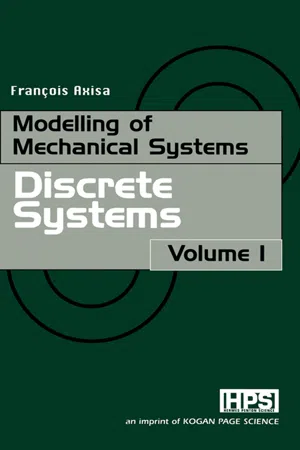
- 300 pages
- English
- ePUB (mobile friendly)
- Available on iOS & Android
Modelling of Mechanical Systems: Discrete Systems
About This Book
This first volume is concerned with discrete systems – the study of which constitutes the cornerstone of all mechanical systems, linear or non-linear. It covers the formulation of equations of motion and the systematic study of free and forced vibrations. The book goes into detail about subjects such as generalized coordinates and kinematical conditions; Hamilton's principle and Lagrange equations; linear algebra in N-dimensional linear spaces and the orthogonal basis of natural modes of vibration of conservative systems. Also included are the Laplace transform and forced responses of linear dynamical systems, the Fourier transform and spectral analysis of excitation and response deterministic signals.Forthcoming volumes in this series:
Vol II: Structural Elements; to be published in June 2005
Vol III: Fluid-structure Interactions; to be published in August 2006
Vol IV: Flow-induced Vibrations; to be published in August 2007* Presents the general methods that provide a unified framework to model mathematically mechanical systems of interest to the engineer, analyzing the response of these systems
* Focuses on linear problems, but includes some aspects of non-linear configuration
* Comprehensive coverage of mathematical techniques used to perform computer-based analytical studies and numerical simulations
* Discusses the mathematical techniques used to perform analytical studies and numerical simulations on the computer
Frequently asked questions
Information
Mechanical systems and equilibrium of forces
1.1 Modelling of mechanical systems
1.1.1 Geometry and distribution of masses
Table of contents
- Cover image
- Title page
- Table of Contents
- Copyright page
- Foreword
- Preface
- Introduction
- Chapter 1: Mechanical systems and equilibrium of forces
- Chapter 2: Principle of virtual work and Lagrange’s equations
- Chapter 3: Hamilton’s principle and Lagrange’s equations of unconstrained systems
- Chapter 4: Constrained systems and Lagrange’s undetermined multipliers
- Chapter 5: Autonomous oscillators
- Chapter 6: Natural modes of vibration of multi degree of freedom systems
- Chapter 7: Forced vibrations: response to transient excitations
- Chapter 8: Spectral analysis of deterministic time signals
- Chapter 9: Spectral analysis of forced vibrations
- Appendices
- Bibliography
- Index
- Series synopsis: Modelling of Mechanical Systems